
|   |

|   |
 e-mail: sunilkothari1933@gmail.com Interface 2016: Festival of international choreographic works Photos courtesy: Sapphire September 25, 2016 The 8th edition of the international dance biennale Interface 2016 was staged in Delhi at Habitat Centre, followed by its performances in Kolkata at Satyajit Ray Auditorium and Kala Mandir on 9, 10 and 11 September. Interface festival for cotemporary expressions covers dance, music, installations, paintings, fashion, theatre and cinema. This was the 25th year of Sapphire Creations established by Sudarshan Chakravorty, Artistic Director, dancer, choreographer and director of Interface along with co-director and director of Artsforward, Paramita Saha. They have been carrying on with grit and determination and deserve congratulations for their sustained efforts. 25 years ago during my tenure as a Professor and Head of Dance Department at Rabindra Bharati University, I used to review performances for The Statesman. Sudarshan had ventured into presenting a story of a gay young man tortured by his sexuality and metaphorically in a work titled Alien Flower, and courageously performed it. But the end was pessimistic as the young man committed suicide. I had commented that the work need not end in such a manner and should be reworked for hope and Sudarshan did so. His tenacity over the years has won him international recognition, since he has been mastering his modern dance technique continuously with a dedicated band of young dancers. His tours abroad have given confidence to him and his company. He has over the years started hosting international contemporary dance companies. Besides presenting them he arranges workshops by the visiting companies and choreographers, exposing the young dancers to diverse techniques. In the process he has evolved his own technique. It has been a Herculean task but he has striven to develop further and encouraged his company to also create their own contemporary works. He showcased some of these works besides presenting two companies from abroad: From Malaysia, Damansara Performing Arts Center and from USA, Khambatta Dance Company, Seattle. From India, Geeta Chandran presented Gandhi: Warp and Weft. 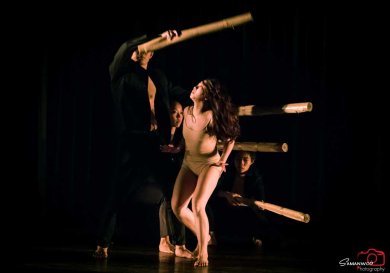 After Dark
On 9th September, the presentation of Damansara's 'After Dark' at Satyajit Ray Auditorium dealt with life experiences and childhood memories. The choreographer uses straw mats and kerosene lights as sources of inspiration, playing with mats, with dancers, on the theme of dreams and dreaming. The dancers hide, wrap and weave in and out of mats to create a dramatic and illusory scenario of being covered and uncovered, being seen and disappearing/unseen. The kerosene light swings and flickers in to both narration and imagination leading spectators to the theme of After Dark. The idea of conquering fear was conveyed successfully. The young dancers are versatile and the director JS Wong was nominated for the best choreography for his work. 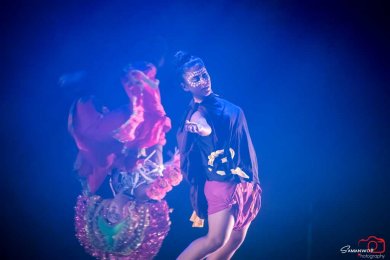
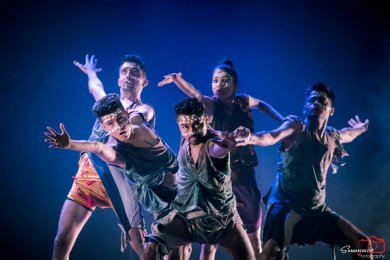
Ekonoma
On 10th September at Kala Mandir, Sapphire Creations presented
'Ekonama-The Beginning at the End' choreographed by Sudarshan
Chakravorty. It is a critique of the rapid depletion of natural
resources and the impending doom of a deadly end to the beautiful world.
Seeded as part of Microsoft Create to inspire Fellowship, the work
traces the story of communities uniting to create a movement to bring
change with a hope for the future. The energetic dance along with
traditional Purulia Chhau dancers with their colourful masks, their
demonic energy, somersaults, acrobatic feats and captivating dance was a
clever ploy to enhance the theme. It was a brilliant juxtaposition with
contemporary dance movements. The depletion of natural resources
were suggested and in resurgence when dogs appear with masks and
continuously attack, and in finale the symbolic resurgence of earth
pregnant with resources, had quite an impact. However, the work needs to
be edited as it is too long. Also it would be good to let Purulia Chhau
dancers at one point remove their masks and perform, demonstrating
their skills. Sudarshan's choreography has evolved and shows maturity.Khambatta Dance Company, with name Khambatta has origin in Parsi community. Cyrus Khambatta is of Parsi origin but has been since birth in USA and had never visited India before. As a choreographer he has a list of various awards and his credentials are impressive with the company performing in major international festivals in USA and Europe. The dancers are well trained with supple, energetic bodies. The theme explores the neurotic impulses that lurk as people attempt to defend their coveted identities against the reality of fate. Truth and betrayal is based on a series of duet dramas of athletic force, giving an impression to search for truth with intimate gesture. The work though abstract in nature, looks at the ways of searching for truth and the fear of betrayal. It dissects the moment of betrayal through assumptions about truth which confronts us. The balancing of the bodies, intertwining had brilliant construct. It was indeed a pleasure to see their work. 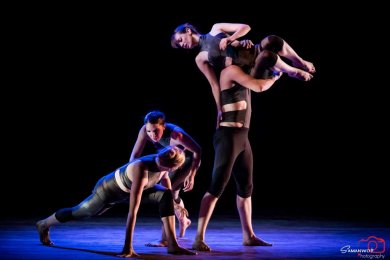 Khambatta Dance Company 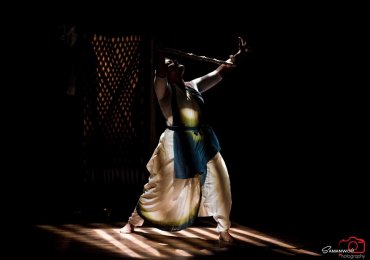 Geeta Chandran 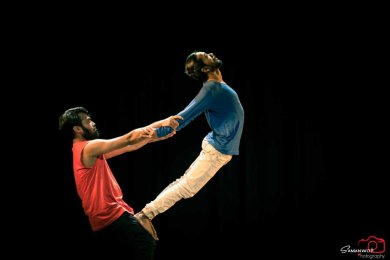 Saurabh Sureka 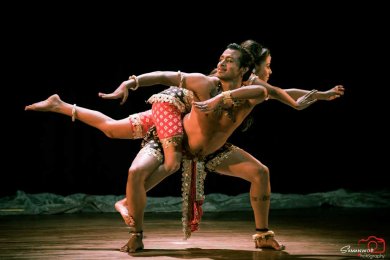 Subhajit Khush Das Sapphire Creations company dancers presented their new choreographic works after Geeta Chandran's Gandhi that has been reviewed earlier. Among young choreographers Saurabh Sureka explored in his work 'From Imbalance to Balance', at times solo, then duet and one dancer dancing alone near a chair. The prop of chair was used cleverly for the theme though like all contemporary works the theme remained abstract. Other works were 'Cross-Mix Ally' by Subhajit Khush Das and 'Situations' by Koushik Das. The one of Dance of Shiva was with traditional attire and one would have liked to see it in other costumes to avoid the over clichéd mythological references. The dancer playing role of Shiva struck balance admirably. The ardhanariswar concept was imaginatively devised and the embrace by Shiva and Parvati reminded one of the sculptures. 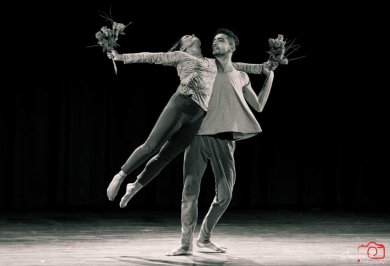 Koushik Das On 11th September at Nandan-3, the small hall was full with several dancers, film makers and film buffs. Astad Deboo gave a comprehensive lecture tracing the origins and developments of contemporary dance from Uday Shankar onwards to major contemporary choreographers including the young choreographers who have been charting their own path, with diverse themes, expressions and body languages. Next year in June 2017, Marg Foundation is bringing out an issue on Contemporary Dance co-edited by Dr. Ketu Katrak of Irvine University, California. It is a welcome publication following my edited volume by Marg Foundation on New Directions in Indian dance which was published in 2000, with a recent reprint, since within a decade and half lot of new choreographers have emerged and their work needs to be recorded. After Astad Deboo's talk, I screened excerpts of film 'Kalpana' of Uday Shankar which even today remains relevant in terms of that visionary genius who with his own technique and expertise in film making dealt with contemporary issues. Few know that Uday Shankar studied film making at Pathe in Paris. The excerpts of choreography of Labour and Machinery are extremely eloquent. The issue of foreign education, dahej to be given for marriage and women throwing away their degrees have been presented through dance in Uday Shankar's technique that he had developed. Ayisha Abraham's 'I saw God Dance', incorporating rare film on Ram Gopal made in 1938 and excerpts of film made by Claude La Morrise was screened for the first time in Kolkata. The young generation and also seniors had not seen it. To some it was a revelation that Ram Gopal was a contemporary of Uday Shankar and was trained in Bharatanatyam, Kathakali and Kathak and had settled in London, performing in 40s and 50s taking USA and Europe by storm. These screenings are important to make young generation of dancers aware of these pioneers. Ratnottama Sengupta's long documentary was on 'Dance in Cinema' with excerpts from several films documenting history of dance in films. Because of the duration of 20 seconds clippings of films, the audience expectation to see more was not meet. But that limitation continued and at times the talk and the images did not coincide. It was a very well studied and scholarly discourse. Instead of 20 seconds limit excerpts, if the documentary / power-point presentation could be reworked with lesser excerpts but of little longer duration, then watching those excerpts would be more interesting. Interface 2016 also honoured in Delhi, Bharatanatyam dancer Prathibha Prahlad, in Kolkata Mohiniattam dancer Mom Ganguly with Smt Bijoya Chakraborty Smriti Puraskar, and critic Dr. Utpal Banerjee and lights designer Dinesh Poddar with Sri Subinoy Chakraborty Puraskar.  Dr. Sunil Kothari is a dance historian, scholar, author and critic. He is honored with Padma Shri, Sangeet Natak Akademi award and Senior Critic Award from Dance Critics Association, NYC. Post your comments Please provide your name and email id when you use the Anonymous profile in the blog to post a comment. All appropriate comments posted with name & email id in the blog will also be featured in the site. |